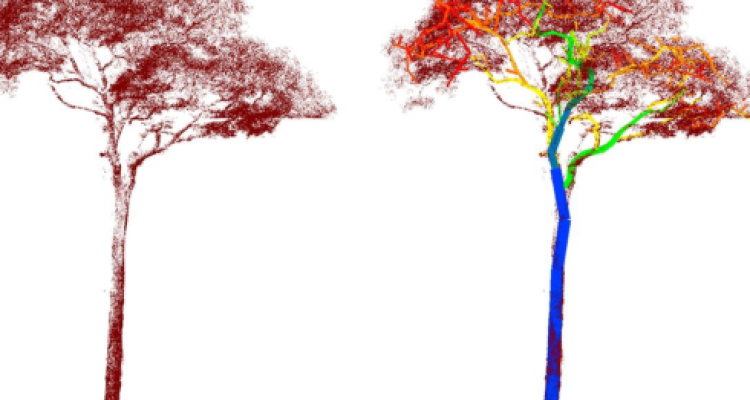
Nieuws
Estimating architecture-based metabolic scaling exponents of tropical trees using terrestrial LiDAR and 3D modelling
An article of Alvaro Lau, Christopher Martius, Harm Bartholomeus, Alexander Shenkin, Tobias Jackson, Yadvinder Malhi, Martin Herold, Lisa Patrick Bentley: Estimating architecture-based metabolic scaling exponents of tropical trees using terrestrial LiDAR and 3D modelling, has been published in Forest Ecology and Management, Volume 439, 1 May 2019, Pages 132-145.
doi:10.1016/j.foreco.2019.02.019
Abstract
The geometric structure of tree branches has been hypothesized to relate to the mechanical safety and efficiency of resource transport within a tree. As such, the topology of tree architecture links physical properties within a tree and influences the interaction of the tree with its environment. Prior work suggests the existence of general principles which govern tree architectural patterns across of species and bio-geographical regions. In particular, West, Brown and Enquist (WBE, 1997) and Savage et al. (2010) derive scaling exponents (branch radius scaling ratio and branch length scaling ratio b) from symmetrical branch parameters and from these, an architecture-based metabolic scaling rate (θ) for the whole tree. With this key scaling exponent, the metabolism (e.g., number of leaves, respiration, etc.) of a whole tree, or potentially a group of trees, can be estimated allometrically. Until now, branch parameter values have been measured manually; either from standing live trees or from harvested trees. Such measurements are time consuming, labour intensive and susceptible to subjective errors. Remote sensing, and specifically terrestrial LiDAR (TLS), is a promising alternative, being objective, scalable, and able to collect large quantities of data without destructive sampling. In this paper, we calculated branch length, branch radius, and architecture-based metabolic rate scaling exponents by first using TLS to scan standing trees and then fitting quantitative structure models (TreeQSM) models to 3D point clouds from nine trees in a tropical forest in Guyana. To validate these TLS-derived scaling exponents, we compared them with exponents calculated from direct field measurements of all branches >10 cm at four scales: branch-level, cumulative branch order, tree-level and plot-level. We found a bias on the estimations of α and β exponents due to a bias on the reconstruction of the branching architecture. Although TreeQSM scaling exponents predicted similar θ as the manually measured exponents, this was due to the combination of α and β scaling exponents which were both biased. Also, the manually measured α and β scaling exponents diverged from the WBE’s theoretical exponents suggesting that trees in tropical environments might not follow the predictions for the symmetrical branching geometry proposed by WBE. Our study provides an alternative method to estimate scaling exponents at both the branch- and tree-level in tropical forest trees without the need for destructive sampling. Although this approach is based on a limited sample of nine trees in Guyana, it can be implemented for large-scale plant scaling assessments. These new data might improve our current understanding of metabolic scaling without harvesting trees.
Keywords: Terrestrial LiDAR; WBE plant scaling exponent; Quantitative structure models; Architecture-based metabolic rate; Destructive harvesting.